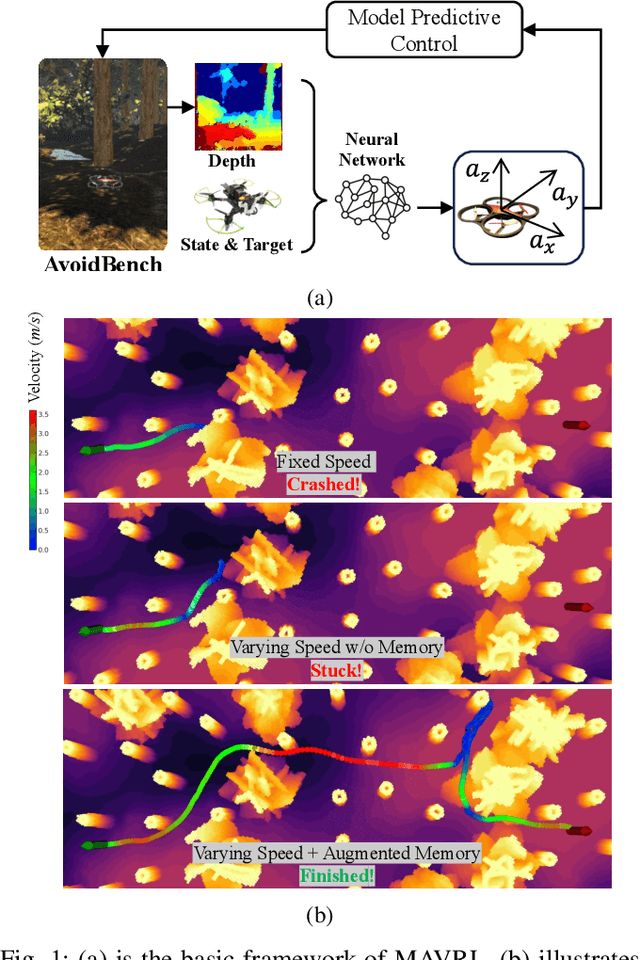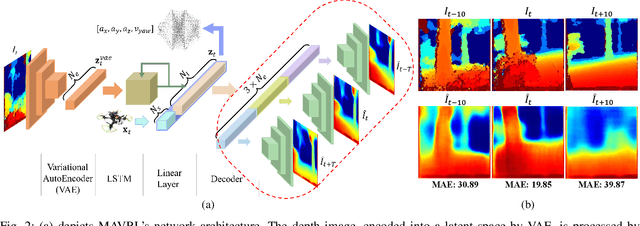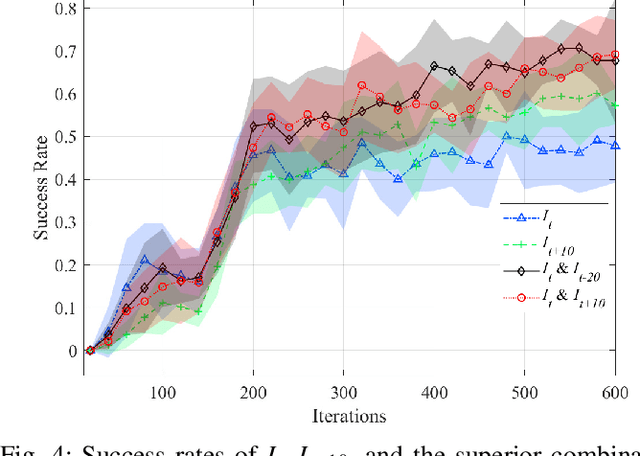Christophe De Wagter
Depth Transfer: Learning to See Like a Simulator for Real-World Drone Navigation
May 18, 2025Abstract:Sim-to-real transfer is a fundamental challenge in robot reinforcement learning. Discrepancies between simulation and reality can significantly impair policy performance, especially if it receives high-dimensional inputs such as dense depth estimates from vision. We propose a novel depth transfer method based on domain adaptation to bridge the visual gap between simulated and real-world depth data. A Variational Autoencoder (VAE) is first trained to encode ground-truth depth images from simulation into a latent space, which serves as input to a reinforcement learning (RL) policy. During deployment, the encoder is refined to align stereo depth images with this latent space, enabling direct policy transfer without fine-tuning. We apply our method to the task of autonomous drone navigation through cluttered environments. Experiments in IsaacGym show that our method nearly doubles the obstacle avoidance success rate when switching from ground-truth to stereo depth input. Furthermore, we demonstrate successful transfer to the photo-realistic simulator AvoidBench using only IsaacGym-generated stereo data, achieving superior performance compared to state-of-the-art baselines. Real-world evaluations in both indoor and outdoor environments confirm the effectiveness of our approach, enabling robust and generalizable depth-based navigation across diverse domains.
Self-Supervised Monocular Visual Drone Model Identification through Improved Occlusion Handling
Apr 30, 2025



Abstract:Ego-motion estimation is vital for drones when flying in GPS-denied environments. Vision-based methods struggle when flight speed increases and close-by objects lead to difficult visual conditions with considerable motion blur and large occlusions. To tackle this, vision is typically complemented by state estimation filters that combine a drone model with inertial measurements. However, these drone models are currently learned in a supervised manner with ground-truth data from external motion capture systems, limiting scalability to different environments and drones. In this work, we propose a self-supervised learning scheme to train a neural-network-based drone model using only onboard monocular video and flight controller data (IMU and motor feedback). We achieve this by first training a self-supervised relative pose estimation model, which then serves as a teacher for the drone model. To allow this to work at high speed close to obstacles, we propose an improved occlusion handling method for training self-supervised pose estimation models. Due to this method, the root mean squared error of resulting odometry estimates is reduced by an average of 15%. Moreover, the student neural drone model can be successfully obtained from the onboard data. It even becomes more accurate at higher speeds compared to its teacher, the self-supervised vision-based model. We demonstrate the value of the neural drone model by integrating it into a traditional filter-based VIO system (ROVIO), resulting in superior odometry accuracy on aggressive 3D racing trajectories near obstacles. Self-supervised learning of ego-motion estimation represents a significant step toward bridging the gap between flying in controlled, expensive lab environments and real-world drone applications. The fusion of vision and drone models will enable higher-speed flight and improve state estimation, on any drone in any environment.
One Net to Rule Them All: Domain Randomization in Quadcopter Racing Across Different Platforms
Apr 30, 2025Abstract:In high-speed quadcopter racing, finding a single controller that works well across different platforms remains challenging. This work presents the first neural network controller for drone racing that generalizes across physically distinct quadcopters. We demonstrate that a single network, trained with domain randomization, can robustly control various types of quadcopters. The network relies solely on the current state to directly compute motor commands. The effectiveness of this generalized controller is validated through real-world tests on two substantially different crafts (3-inch and 5-inch race quadcopters). We further compare the performance of this generalized controller with controllers specifically trained for the 3-inch and 5-inch drone, using their identified model parameters with varying levels of domain randomization (0%, 10%, 20%, 30%). While the generalized controller shows slightly slower speeds compared to the fine-tuned models, it excels in adaptability across different platforms. Our results show that no randomization fails sim-to-real transfer while increasing randomization improves robustness but reduces speed. Despite this trade-off, our findings highlight the potential of domain randomization for generalizing controllers, paving the way for universal AI controllers that can adapt to any platform.
Multi-objective Evolution of Drone Morphology
Feb 03, 2025



Abstract:The design of multicopter drones has remained almost the same since its inception. While conventional designs, such as the quadcopter, work well in many cases, they may not be optimal in specific environments or missions. This paper revisits rotary drone design by exploring which body morphologies are optimal for different objectives and constraints. Specifically, an evolutionary algorithm is used to produce optimal drone morphologies for three objectives: (1) high thrust-to-weight ratio, (2) high maneuverability, and (3) small size. To generate a range of optimal drones with performance trade-offs between them, the non-dominated sorting genetic algorithm II, or NSGA-II is used. A randomly sampled population of 600 is evolved over 2000 generations. The NSGA-II algorithm evolved drone bodies that outperform a standard 5-inch 220 mm wheelbase quadcopter in at least one of the three objectives. The three extrema in the Pareto front show improvement of 487.8%, 23.5% and 4.8% in maneuverability, thrust-to-weight ratio and size, respectively. The improvement in maneuverability can be attributed to the tilt angles of the propellers, while the increase in thrust-to-weight ratio is primarily due to the higher number of propellers. The quadcopter is located on the Pareto front for the three objectives. However, our results also show that other designs can be better depending on the objectives.
MAVRL: Learn to Fly in Cluttered Environments with Varying Speed
Feb 13, 2024



Abstract:Many existing obstacle avoidance algorithms overlook the crucial balance between safety and agility, especially in environments of varying complexity. In our study, we introduce an obstacle avoidance pipeline based on reinforcement learning. This pipeline enables drones to adapt their flying speed according to the environmental complexity. Moreover, to improve the obstacle avoidance performance in cluttered environments, we propose a novel latent space. The latent space in this representation is explicitly trained to retain memory of previous depth map observations. Our findings confirm that varying speed leads to a superior balance of success rate and agility in cluttered environments. Additionally, our memory-augmented latent representation outperforms the latent representation commonly used in reinforcement learning. Finally, after minimal fine-tuning, we successfully deployed our network on a real drone for enhanced obstacle avoidance.
End-to-end Reinforcement Learning for Time-Optimal Quadcopter Flight
Nov 28, 2023



Abstract:Aggressive time-optimal control of quadcopters poses a significant challenge in the field of robotics. The state-of-the-art approach leverages reinforcement learning (RL) to train optimal neural policies. However, a critical hurdle is the sim-to-real gap, often addressed by employing a robust inner loop controller -an abstraction that, in theory, constrains the optimality of the trained controller, necessitating margins to counter potential disturbances. In contrast, our novel approach introduces high-speed quadcopter control using end-to-end RL (E2E) that gives direct motor commands. To bridge the reality gap, we incorporate a learned residual model and an adaptive method that can compensate for modeling errors in thrust and moments. We compare our E2E approach against a state-of-the-art network that commands thrust and body rates to an INDI inner loop controller, both in simulated and real-world flight. E2E showcases a significant 1.39-second advantage in simulation and a 0.17-second edge in real-world testing, highlighting end-to-end reinforcement learning's potential. The performance drop observed from simulation to reality shows potential for further improvement, including refining strategies to address the reality gap or exploring offline reinforcement learning with real flight data.
Optimality Principles in Spacecraft Neural Guidance and Control
May 22, 2023Abstract:Spacecraft and drones aimed at exploring our solar system are designed to operate in conditions where the smart use of onboard resources is vital to the success or failure of the mission. Sensorimotor actions are thus often derived from high-level, quantifiable, optimality principles assigned to each task, utilizing consolidated tools in optimal control theory. The planned actions are derived on the ground and transferred onboard where controllers have the task of tracking the uploaded guidance profile. Here we argue that end-to-end neural guidance and control architectures (here called G&CNets) allow transferring onboard the burden of acting upon these optimality principles. In this way, the sensor information is transformed in real time into optimal plans thus increasing the mission autonomy and robustness. We discuss the main results obtained in training such neural architectures in simulation for interplanetary transfers, landings and close proximity operations, highlighting the successful learning of optimality principles by the neural model. We then suggest drone racing as an ideal gym environment to test these architectures on real robotic platforms, thus increasing confidence in their utilization on future space exploration missions. Drone racing shares with spacecraft missions both limited onboard computational capabilities and similar control structures induced from the optimality principle sought, but it also entails different levels of uncertainties and unmodelled effects. Furthermore, the success of G&CNets on extremely resource-restricted drones illustrates their potential to bring real-time optimal control within reach of a wider variety of robotic systems, both in space and on Earth.
Guidance & Control Networks for Time-Optimal Quadcopter Flight
May 04, 2023



Abstract:Reaching fast and autonomous flight requires computationally efficient and robust algorithms. To this end, we train Guidance & Control Networks to approximate optimal control policies ranging from energy-optimal to time-optimal flight. We show that the policies become more difficult to learn the closer we get to the time-optimal 'bang-bang' control profile. We also assess the importance of knowing the maximum angular rotor velocity of the quadcopter and show that over- or underestimating this limit leads to less robust flight. We propose an algorithm to identify the current maximum angular rotor velocity onboard and a network that adapts its policy based on the identified limit. Finally, we extend previous work on Guidance & Control Networks by learning to take consecutive waypoints into account. We fly a 4x3m track in similar lap times as the differential-flatness-based minimum snap benchmark controller while benefiting from the flexibility that Guidance & Control Networks offer.
An Adaptive Control Strategy for Neural Network based Optimal Quadcopter Controllers
Apr 26, 2023



Abstract:Developing optimal controllers for aggressive high-speed quadcopter flight is a major challenge in the field of robotics. Recent work has shown that neural networks trained with supervised learning can achieve real-time optimal control in some specific scenarios. In these methods, the networks (termed G&CNets) are trained to learn the optimal state feedback from a dataset of optimal trajectories. An important problem with these methods is the reality gap encountered in the sim-to-real transfer. In this work, we trained G&CNets for energy-optimal end-to-end control on the Bebop drone and identified the unmodeled pitch moment as the main contributor to the reality gap. To mitigate this, we propose an adaptive control strategy that works by learning from optimal trajectories of a system affected by constant external pitch, roll and yaw moments. In real test flights, this model mismatch is estimated onboard and fed to the network to obtain the optimal rpm command. We demonstrate the effectiveness of our method by performing energy-optimal hover-to-hover flights with and without moment feedback. Finally, we compare the adaptive controller to a state-of-the-art differential-flatness-based controller in a consecutive waypoint flight and demonstrate the advantages of our method in terms of energy optimality and robustness.
Neuromorphic Control using Input-Weighted Threshold Adaptation
Apr 18, 2023



Abstract:Neuromorphic processing promises high energy efficiency and rapid response rates, making it an ideal candidate for achieving autonomous flight of resource-constrained robots. It will be especially beneficial for complex neural networks as are involved in high-level visual perception. However, fully neuromorphic solutions will also need to tackle low-level control tasks. Remarkably, it is currently still challenging to replicate even basic low-level controllers such as proportional-integral-derivative (PID) controllers. Specifically, it is difficult to incorporate the integral and derivative parts. To address this problem, we propose a neuromorphic controller that incorporates proportional, integral, and derivative pathways during learning. Our approach includes a novel input threshold adaptation mechanism for the integral pathway. This Input-Weighted Threshold Adaptation (IWTA) introduces an additional weight per synaptic connection, which is used to adapt the threshold of the post-synaptic neuron. We tackle the derivative term by employing neurons with different time constants. We first analyze the performance and limits of the proposed mechanisms and then put our controller to the test by implementing it on a microcontroller connected to the open-source tiny Crazyflie quadrotor, replacing the innermost rate controller. We demonstrate the stability of our bio-inspired algorithm with flights in the presence of disturbances. The current work represents a substantial step towards controlling highly dynamic systems with neuromorphic algorithms, thus advancing neuromorphic processing and robotics. In addition, integration is an important part of any temporal task, so the proposed Input-Weighted Threshold Adaptation (IWTA) mechanism may have implications well beyond control tasks.
 Add to Chrome
Add to Chrome Add to Firefox
Add to Firefox Add to Edge
Add to Edge